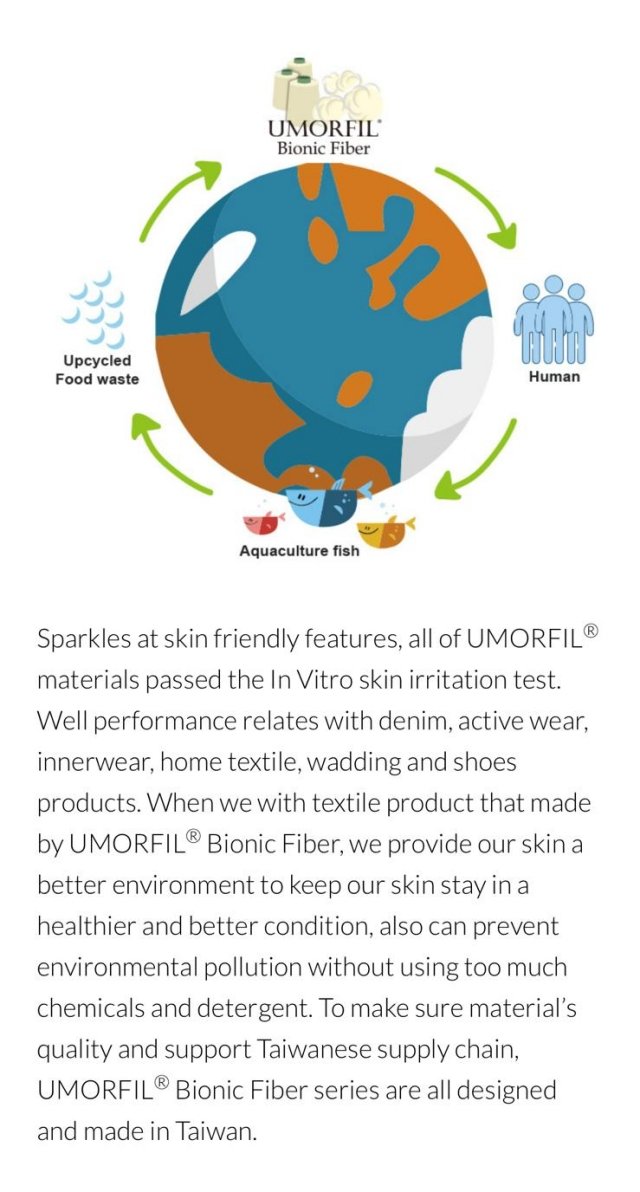Hello, Darlings!
Welcome back, and welcome to another blog from the Future of Fashion, a place where we can magically impact the future of fashion, beauty and creativity for all living creatures.
I’m always excited to look at new fabrics and to understand and explore what can be used to make materials. I’m also very excited to see new fabrics that come from waste or things that are regularly discarded. This waste, rather than being discarded, is being used for something new and innovative.
Recently, I came across one such series of fabrics called Umorfil®. Umorfil® is a bionic fibre. It was founded by Dr. James, a well-known expert and innovator in the Taiwanese textile industry. It is made from upcycled agriculture, or rather fish scale, turning it into textiles.
The name Umorfil® originates from the combination of Latin Umor and French “fil”. “Umor” means moisture, and “Fil” means “yarn”. Like wool and silk, the Umorfil® bionic fibre series has natural properties in temperature control and deodorising. The fibre series contributes to marine ecology by using waste from the fishing industry. This waste being put to good use is a huge benefit and a complete win-win. The other benefit is that this is not only sustainable but also good for the skin when worn and has excellent natural functions.
All these materials have been designed and made in Taiwan. I think many of us in the industry know about the revolutionary S.Café® yarn. This technology recycles used coffee grounds and utilises its natural deodorisation qualities in the fibre and fabrics produced.
Coffee, like fish, is widely used in modern-day consumption. So, the brilliant people from Singtex (the fabric mill) came up with the idea of using all these waste grounds to make fibre and, ultimately, fabric. Incorporating coffee grounds alters the filament properties, resulting in outstanding performance.
S.Café® mixes processed coffee grounds and recycled polymer to create a master batch that then goes for spinning. The S.Café® yarn has been spun into various different qualities. The coffee fibre provides UV properties, odour controllability, and fast drying, which outperforms cotton by 200% and polyester. And these are permanent functions. They are not finishes that will wash out but live in the properties of the fabric.
So let’s get back to Umorfhil®. Umorfil® uses supramolecular technology to integrate collagen peptide amino acids sourced from up-cycled food waste, aquaculture, and fish scales. This is incorporated with cellulosic fibre, polyester and nylon to create the bionic function fibre series. The result is some extraordinary fabrics, which have properties like silk, wool and other natural fibres. Some of the amazing performance qualities are wicking, natural deodorising and anti-UV, and they come with many certifications. These certifications include FSC (Forest Stewardship Council) Oekotex and a Halal certification. There are so many great benefits to the Umorfil® Series. Not only is it sustainable, but it also has the benefits provided by nature.
These two fabrics are not the only ones with extraordinary natural benefits and qualities utilising waste materials. They are, however, excellent examples of what is possible in the materials innovation field.
I’m very passionate about sustainability and sustainable materials, especially sustainable innovation. Having such huge amounts of chemicals in the items we’re wearing isn't necessary. Nature gave us some beautiful qualities. Those that naturally work for us as humans include cotton, wool, hemp, and, controversially, leather and fur. Yet now, the largest material group is made from oil, and as we can see, this is not completely necessary. There are other alternatives. Fortunately, there are also great innovators such as those we have discussed here. As consumers, what we can do is seek out such fabrics, buy them and wear them. These are excellent for all of our athletic apparel, which is where we really need the deodorising, wicking and other performance metrics. This sector is also where polyester is used the most and where we have the most issues with pollution and lack of recycling. So here’s to a future of naturally synthetic materials.
What do you think about these materials?
As always, have fun, love life, and enjoy fashion.
Kate xx


